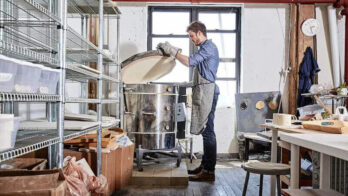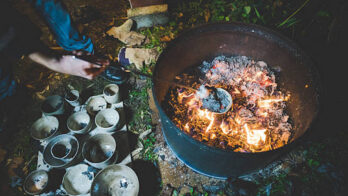You’ve most likely invested a significant amount of money on purchasing a kiln, and the worst time to learn that something is wrong is when you’re trying to fire your pieces. Regular preventative kiln maintenance is a far superior strategy.
Investing the time to maintain your kiln in good working order will almost definitely save you both time and money over the long term. By following a few simple principles, you may extend the life of your kiln and its components by several years.
Carry Out a Thorough Inspection of the Lid
During each fire, the kiln lid expands and contracts in reaction to the heat. Because of this, tightening the lid band on occasion will be required. Tighten the band with care, using the proper tool, and taking care not to strip any threads along the way.
The majority of kiln lids are built with a protective coating on the inside of the kiln lid. This coating was applied to improve the heat insulation of the lid and to stop brick dust from dropping into the kiln during the firing process. Of course, this is something that you cannot avoid.
Cracks in the lid may form due to all of the expansion and contraction that has occurred over the years. The majority of cracks are purely cosmetic and will not affect your firings. However, a minor fissure can sometimes develop into a serious problem that you must address with kiln cement.
Check the Inside of the Kiln
Your kiln should only include your components, pins, brick, kiln furniture/posts, and kiln cleaned shelves when you’re not using it for a project like this. It’s best to remove everything from the kiln’s sidewalls before firing (glaze and slip and clay, glass, silica sand).
We’re doing it for the exact reason we vacuum the lid. A kiln’s sidewalls and heating components could be damaged if this material is left in there. You can use a little screwdriver or knife to remove the substance from the surface. Also, some of the sidewall brick may come loose and fall to the ground. Most of the time, cracks are only aesthetic and won’t affect your firings.
It is possible to fix a tiny crack with kiln cement when it becomes an issue. However, if cement is put on them, you can damage the heating elements, so be careful when working around them.
Perform an Internal Element Inspection
It’s important to keep an eye out for rust, bulges and thinning or thickening areas on your elements. You’ll inevitably have to replace your kiln’s elements at some point. The more firings you undertake and the climate where your kiln is located greatly impact element wear.
When you fire for a long period of time, the elements will begin to show wear. The element will be more durable the thicker the gauge of wire used in the coil. Please keep in mind that each manufacturer has made a meticulous effort to size the element coils to ensure that they can handle the amount of amperage required to complete the job successfully.
Ensure you consult with the manufacturer if you think it is necessary to replace your elements. They will be able to establish the proper element size for your kiln.
Conduct an Electrical Inspection
Check the power cord, receptacle, and plug for signs of discoloration or heat regularly. Check that all of the connections in the socket and plug are secure. Examine the plug regularly for corrosion or black patches. If corrosion or discoloration develops, you should replace the plug and receptacle.
Check the plug and socket regularly to ensure they are not too hot. Identify any loose connections or corrosion that may be present if the unit feels hot. Do not fire until the problem has been resolved. It may be essential to replace the cord set or the socket.
Kiln Maintenance Checklists
If you use your kiln regularly, some inspections should be completed before every firing, while others may only be required monthly or even yearly, depending on how often you use your kiln.
Kiln Maintenance Before Each Firing
- Check the inside of the kiln for anything that doesn’t look right.
- Remove any loose bits of firebrick from the walls or the lid of the fireplace. When the brick elements begin to bulge out or sag, you should replace them. Element staples will help hold elements in place for a short period of time.
- Remove any glaze splatters from the walls, shelves, supports, or the bottom of the kiln.
- Double-check shelves for cracks. Do not use a shelf that has been cracked.
- You can use fresh kiln wash to fill in any bare patches on shelves (most important in glaze firings).
- Check whether there are any loose or swollen elements. To keep them in place, use element pins.
- If your kiln has a kiln sitter, remove any kiln wash residue from the sensing rod and cone supports and recoat with fresh kiln wash. This will keep the cones from adhering. The cone supports must be replaced if any material cannot be removed. Make sure the rod can move freely by raising and lowering it.
- If you have a thermocouple in your kiln can be checked for cracks by gently shaking it. Make sure it’s at least an inch deep within the kiln. It won’t work if it gets knocked and forced back into the brick.
- The cord should not come into contact with the kiln’s sides or be near anything flammable.
- Ensure that nothing is in front of the kiln that would prevent the weight from falling on a kiln sitter (if equipped).
Monthly Kiln Maintenance
- Clean the inside of your kiln using a vacuum.
- Check to see that your kiln is level.
- If your kiln is equipped with a kiln sitter, you should remove and inspect your cone supports. If they are bent in any way, you should replace them.
- On the kiln sitter, make sure the porcelain tube assembly is in good working order (if equipped). If there are any cracks or chips, you should replace them.
- If necessary, tighten the kiln lid and jacket. The majority of kilns contain screws on only one side.
- If your kiln is equipped with a kiln sitter, utilize the firing gauge to ensure that the sitter is operating correctly.
- Examine the socket and plug for signs of corrosion or melted areas before using them. If you notice any problems, you should replace the plug and socket as soon as possible. If your kiln is modular or has a ring, make sure the connections between parts are working well.
- Remove any loose kiln wash from the shelves with a putty knife and recoat the shelves. Make certain that the bottom of your kiln has a decent coating as well. It is preferable to burn pieces on a shelf above the bottom of the kiln, but you should still coat the bottom of the kiln to protect it from any small chips of glaze or crystals that may fall to the bottom.
- If your kiln is equipped with an exhaust vent, inspect the exhaust tubing for cracks or fractures. Also, vacuum the vent to eliminate any dust that may have accumulated.
Annual Kiln Maintenance
- Check the kiln frame for corrosion; wire brush any rusted sections and repaint with Kill Rust or a rust-proofing paint to prevent further corrosion.
- Check that the kiln door seals properly (perform this while the kiln is at a high temperature and burning red-orange) and that any ceramic fiber seals need to be replaced if worn.
- Examine the level of kiln brick cracking and any elements that may have fallen out of their tracks (a qualified electrician can ‘pin’ these back into place with Kanthal wire if necessary). You should note that some cracking in the brickwork is to be expected.
- If your kiln has a flat top, make sure that the top does not slump into the kiln cavity. Although you can support this with a kiln shelf on very long supports, the shelf will eventually need to be replaced.
- It is necessary to ensure that the contact mechanism on the kiln door is connected to the kiln body to complete the electric circuit. Poor contact may become no contact as the kiln heats and expands, causing the kiln to shut down in the middle of the firing. The moveable screw that hangs below the kiln door should be checked for tightness. Check to see that it is in the proper position and has not been slammed against a stack of unloaded shelves resting on the kiln’s exterior.
- Cracked shelves should be thrown away, re-cut, or broken up for use in a fire. Never operate with shelves that are cracked.
- Check the accuracy of your thermocouple by firing it at least once each year with a set of three pyrometric cones that are placed close to your thermocouple. Have a cone temperature equivalence chart on hand to be certain of the temperature the cones are indicating.
Conclusion
Proper kiln maintenance and care is a simple task that, if completed with care and attention, can save you valuable downtime and thousands of dollars in maintenance costs. I hope you find these tip useful! stick around and check out our great guides on pottery and ceramics.
Featured image courtesy of the The Kiln Guy



Enter your email below to get our FREE beginner friendly tips.
By entering your email address you agree to receive emails from Potters Passion. We'll respect your privacy and you can unsubscribe at any time.



